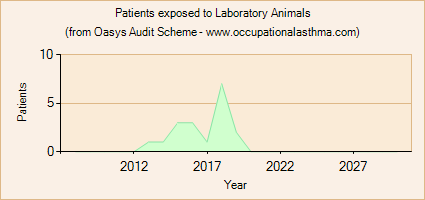Laboratory Animals
|

|
Super Categories
Subcategories
Known Synonyms
None
About a third of all laboratory workers handling rats, mice, rabbits, guinea-pigs develop some form of hypersensitivity reaction, usually in the first few years of exposure. In one study, 15% had a reaction in the first year of exposure, 2% of this was occupational asthma. Cross sectional studies commonly show occupational asthma in 4 to 10% with twice as many having rhinitis or urticaria, commonly caused by bites and scratches. The main allergens are urinary proteins, particularly a prealbumim in the mouse and a
2-globulin and prealbumin in the rat, although there are probably some proteins derived from the pelt as well. Exposure to washed pelts does not appear to cause reactions.
Exposure levels are highest when examining animals, intermediate when cleaning cages and relatively low when weighing and dosing animals. Exposure levels also vary with the density of animals in the room and the rate of air change and the litter used. Background levels in animal rooms are higher at night when rodents are active.
Most workers with occupational asthma have specific IgE antibodies to urinary proteins, but these are also found in a number of symptomless individuals. Those with occupational urticaria and rhinitis do not have increased levels of IgE antibodies compared with symptomless individuals. Occupational asthma is more common in atopic individuals. Some severe reactions can occur in highly sensitised workers when in contact with contaminated laboratory clothes. Specific IgE antibodies decline after exposure ceases with a half life of 6 to 12 months.
| Agent |
Rats, Mice, Guinea-pigs, rabbits, hamsters |
| Job |
Laboratory Animal Workers |
| Air Measurements |
Urinary antigens detectable by immunoassay |
| Specific IgE |
Positive to urinary antigens |
| Biological Monitoring |
Not done |
| Skin prick test |
Positive to urinary antigens |
| Non-specific reactivity |
Hyperreactive in many workers |
| Serial Peak Flow |
Usually positive, immediate reactions common |
| Induced sputum |
|
| FENO |
|
| Specific Challenge |
Many studies with positive challenges |
| Follow-up |
Half life for IgE 6 to 12 months. Prognosis perhaps better than some other forms of occupational asthma. |
Oasys Notifications for Laboratory Animals
The Oasys Audit scheme started midway through 2010 and collects agents typed in through the Oasys program. The years before 2010 show old data entered during 2010 or later and are likely to have many fewer notifications. We expect Oasys to become more widely adopted as time goes by so increasing notifications does not necessarily mean an increasing problem.

|
Selected References for Laboratory Animals
 |
Nieuwenhuijsen MJ, Putcha V, Gordon S, Heederik D, Venables KM, Cullinan P, Newman Taylor AJ,
Exposure-response relationships among laboratory workers exposed to rats,
Occup Environ Med,
2002;60:104-108,
|
|
|




|
|
|